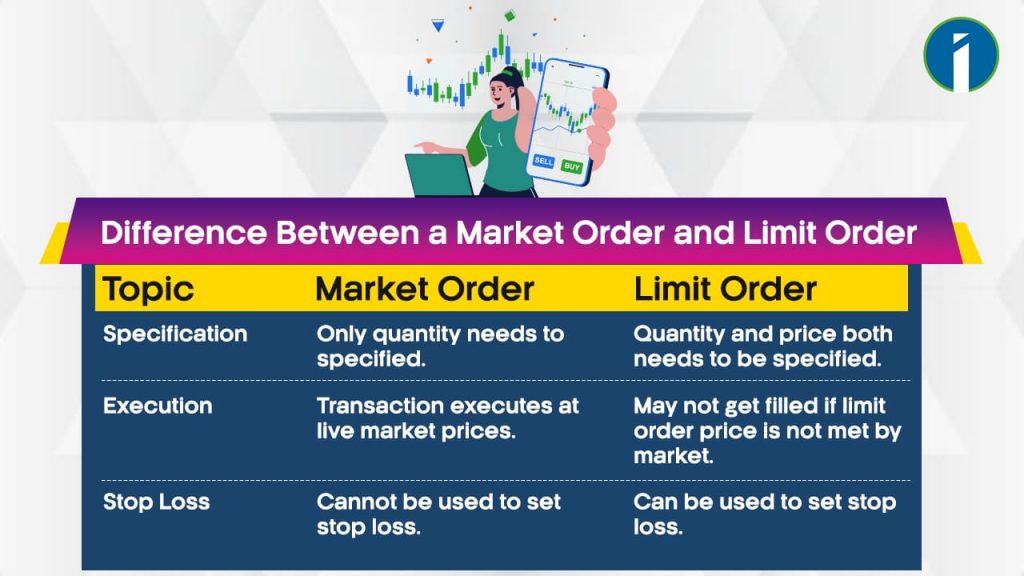In a stock market when you as investor/trader wants to Buy or Sell a stock, then you have to place an order. In technical terms, Buying or Selling transactions are called Buy Order or Sell Order.
There are two types of Buy or Sell Order:
- Market Order and
- Limit Order.
Basically, Market Order and Limit Order are two different ways of Purchasing and Selling in the market.
Market Order

- A Market Order is an instruction to Buy or Sell a security immediately at the current price. Market Orders are best used for Buying or Selling large-cap stocks, futures, or ETFs.
How Does a Market Order Work?
A Market Order works by instructing a broker or trading platform to Buy or Sell stocks at the best available price in the current market.
After the order is placed, it goes to the exchange, then the stock exchange completes the Buy Order by matching the investor’s Sell Order.
What Should You Know Before Placing a Market Order?
Before placing a Market Order, it’s important to understand that the execution price may not be exactly as expected due to market fluctuations. As stock market prices change within seconds, so the order price and the actual execution price may differ.
The default price type is generally “Market.” That makes it a Market Order. The investor is not setting a price but is indicating a willingness to pay the Current Market Price.
Let’s understand it with an example.
- Let’s assume, an investor wants to buy shares of a company right away at the Current Market Price. He placed a market order instructing his broker to buy those shares immediately, regardless of the exact price. His broker executes the order at the best available price in the market at that moment. So, if the current market price is Rs.50 per share, His Market Order will be filled at around that price.
Limit Order

- Limit Order means an order to Buy or Sell an instrument at a specified price.
How Does a Limit Order Work?
A Limit Order allows an investor to set a maximum acceptable purchase price amount or a minimum acceptable sales price while placing an order. The order will be only executed when the market reaches the desired price.
Limit Orders are commonly used by professional traders and day traders who may be making a profit by Buying and Selling huge quantities of shares very quickly in order to exploit tiny changes in their prices.
What Should You Know Before Placing a Limit Order?
Before placing a Limit Order, it is very important to know the desired price at which you want to Buy or Sell the instrument. Remember that the order may not be filled if the market does not touch the specified price.
In case, at a certain level of price, there are multiple orders then chronologically orders will be executed as per the availability of shares. Limit Orders don’t have a 100% success rate.
- Let’s assume, the Current Market Price of a share is ₹1000. Client wishes to buy when the price drops to ₹950. A Buy Limit Order can be placed at ₹950 and the stock will be bought at ₹950 or lower.
The advantage of a Limit Order is that the share is bought at the desired price. However, depending on the availability of a counter order for the specified quantity or price, the order may not be completely filled, resulting in partial execution.
Difference Between a Market Order and Limit Order

Which one is better between the Market Order and Limit Order?
The choice between a market order and a limit order depends on your trading strategy and priorities.
A Market Order, is simply more useful for long term hold investors who may not bother about minor price fluctuations.
Limit Orders are particularly used in volatile markets or when trading liquid securities, as it gives greater control over price. Additionally Limit Order are favored by investors with specific price targets or those aiming to capitalize on short-term price fluctuations.
Conclusion:
In general, Market Orders are better for immediate execution, while Limit Orders are better for controlling the price at which you buy or sell securities. It ultimately depends on investors or traders’ specific goals and risk tolerance.
1. How does a market order work?
A market order executes at the best available price in the market at the time the order is placed.
2. How does a limit order work?
A limit order will only execute at the specified price or better, ensuring control over the purchase or sale price.
3. Which type of order is typically faster: market or limit?
Market orders are typically faster as they execute immediately, while limit orders may take time to execute if the specified price is not met.
4. Which order type is more suitable for volatile markets : market or limit?
Limit orders are more suitable for volatile markets as they allow traders to set precise parameters for their trades.
5. Which order type offers more control over trade execution : market or limit?
Limit orders offer more control over trade execution as traders can specify the price at which they are willing to buy or sell, whereas market orders execute immediately at the prevailing market price.



Leave a Reply